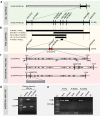Loss-of-function of an α-SNAP gene confers resistance to soybean cyst nematode
- PMID: 37993454
- PMCID: PMC10665432
- DOI: 10.1038/s41467-023-43295-y
Loss-of-function of an α-SNAP gene confers resistance to soybean cyst nematode
Abstract
Plant-parasitic nematodes are one of the most economically impactful pests in agriculture resulting in billions of dollars in realized annual losses worldwide. Soybean cyst nematode (SCN) is the number one biotic constraint on soybean production making it a priority for the discovery, validation and functional characterization of native plant resistance genes and genetic modes of action that can be deployed to improve soybean yield across the globe. Here, we present the discovery and functional characterization of a soybean resistance gene, GmSNAP02. We use unique bi-parental populations to fine-map the precise genomic location, and a combination of whole genome resequencing and gene fragment PCR amplifications to identify and confirm causal haplotypes. Lastly, we validate our candidate gene using CRISPR-Cas9 genome editing and observe a gain of resistance in edited plants. This demonstrates that the GmSNAP02 gene confers a unique mode of resistance to SCN through loss-of-function mutations that implicate GmSNAP02 as a nematode virulence target. We highlight the immediate impact of utilizing GmSNAP02 as a genome-editing-amenable target to diversify nematode resistance in commercially available cultivars.
© 2023. The Author(s).
Conflict of interest statement
The authors have filed the following US provisional patent applications—No. 63/387,635 filed on 12/15/2022 and No. 63/503,811 filed on 05/23/2023.
Figures





References
-
- Rincker K, Cary T, Diers BW. Impact of soybean cyst nematode resistance on soybean yield. Crop Sci. 2017;57:1373–1382. doi: 10.2135/cropsci2016.07.0628. - DOI
-
- Allen TW, et al. Soybean yield loss estimates due to diseases in the United States and Ontario, Canada, from 2010 to 2014. Plant Health Prog. 2017;18:19–27. doi: 10.1094/PHP-RS-16-0066. - DOI
-
- Tylka GL, Marett CC. Known distribution of the soybean cyst nematode, Heterodera glycines, in the United States and Canada, 1954 to 2017. Plant Health Prog. 2017;18:167–168. doi: 10.1094/PHP-05-17-0031-BR. - DOI
-
- Medina R, Taylor CG. Improving crop rotation efficiency for soybean cyst nematode management. Phytopathology. 2015;105:94–94.
Publication types
MeSH terms
Substances
LinkOut - more resources
Full Text Sources

